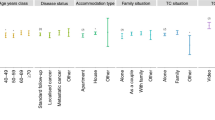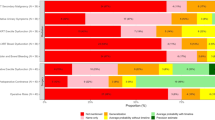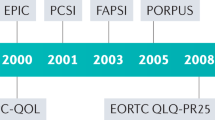Abstract
Prostate cancer is being diagnosed earlier and in higher numbers than ever before. The nature of the disease means many patients have to be monitored regularly and for a prolonged period leading to increased pressure on urology outpatient resources and inconvenience for the patient. Here we investigate patient satisfaction with a nurse-led telephone-based follow-up clinic and compare it to satisfaction with traditional outpatient consultations. A Consultation Satisfaction Questionnaire (CSQ) evaluating four domains, namely General Satisfaction (GS), Professional Care (PC), Depth of Relationship (DR) and Perceived Time (PT) was used to assess satisfaction in three groups. Group 1 consisted of 299 patients attending the outpatient department before commencing telephone consultations; Group 2 consisted of 163 men attending outpatients after commencement of the telephone consultations; and Group 3 was the telephone group (234 men). We demonstrated no significant difference in GS or PC between Group 1 and Group 3 or Group 2 and Group 3, although DR and PT was significantly lower in the telephone group compared with Group 1. We also found that waiting times were significantly shorter in the telephone group. In conclusion, telephone follow-up appears to be an acceptable alternative to outpatient follow-up in terms of GS and PC and appears to be more convenient for the patient, although these benefits come at the expense of loss of DR and PT with the clinician.
This is a preview of subscription content, access via your institution
Access options
Subscribe to this journal
Receive 4 print issues and online access
$259.00 per year
only $64.75 per issue
Buy this article
- Purchase on Springer Link
- Instant access to full article PDF
Prices may be subject to local taxes which are calculated during checkout
Similar content being viewed by others
References
Hsing AW, Tsao L, Devesa SS . International trends and patterns of prostate cancer incidence and mortality. Int J Cancer 2000; 85: 60–67.
Takayama TK, Vessella RL, Brawer MK, Noteboom J, Lange PH . The enhanced detection of persistent disease after prostatectomy with a new prostate specific antigen immunoassay. J Urol 1993; 150: 374–378.
Nixon RG, Lilly JD, Liedtke RJ, Batjer JD . Variation of free and total prostate-specific antigen levels: the effect on the percent free/total prostate-specific antigen. Arch Pathol Lab Med 1997; 121: 385–391.
Gosselaar C, Roobol MJ, Schroder FH . Prevalence and characteristics of screen-detected prostate carcinomas at low prostate-specific antigen levels: aggressive or insignificant? BJU Int 2005; 95: 231–237.
Parker C . Active surveillance of early prostate cancer: rationale, initial results and future developments. Prostate Cancer Prostatic Dis 2004; 7: 184–187.
Hanlon AL, Diratzouian H, Hanks GE . Post treatment prostate-specific antigen nadir highly predictive of distant failure and death from prostate cancer. Int J Radiat Oncol Biol Phys 2002; 53: 297–303.
Wasson J, Gaudette C, Whaley F, Sauvigne A, Baribeau P, Welch HG . Telephone care as a substitute for routine clinic follow-up. JAMA 1992; 267: 1788–1793.
Fallis WM, Scurrah D . Outpatient laparoscopic cholecystectomy: home visit versus telephone follow-up. Can J Surg 2001; 44: 39–44.
Reilly J, Noone A, Clift A, Cochrane L, Johnston L, Rowley DI et al. A study of telephone screening and direct observation of surgical wound infections after discharge from hospital. J Bone Jt Surg Br 2005; 87: 997–999.
Welch HG, Johnson DJ, Edson R . Telephone care as an adjunct to routine medical follow-up. A negative randomized trial. Eff Clin Pract 2000; 3: 123–130.
Booker J, Eardley A, Cowan R, Logue J, Wylie J, Caress AL . Telephone first post-intervention follow-up for men who have had radical radiotherapy to the prostate: evaluation of a novel service delivery approach. Eur J Oncol Nurs 2004; 8: 325–333.
Gupta S, Shergill I, Herdman J, Matanhelia SS, Watson ME, Blades RA . Patient satisfaction with a nurse-led prostate cancer follow-up clinic. Br J Urol 2004; 93: 113–114.
Bailey DE, Mishel MH, Belyea M, Stewart JL, Mohler J . Uncertainty intervention for watchful waiting in prostate cancer. Cancer Nurs 2004; 27: 339–346.
Mishel MH, Germino BB, Belyea M, Stewart JL, Bailey DE, Mohler J et al. Moderators of an uncertainty management intervention: for men with localized prostate cancer. Nurs Res 2003; 52: 89–97.
Mishel MH, Belyea M, Germino BB, Stewart JL, Bailey DE, Robertson C et al. Helping patients with localized prostate carcinoma manage uncertainty and treatment side effects: nurse delivered psychoeducational intervention over the telephone. Cancer 2002; 94: 1854–1866.
Baker R . Development of a questionnaire to assess patients' satisfaction with consultations in general practice. Br J Gen Pract 1990; 40: 487–490.
Baker R, Whitfield M . Measuring patient satisfaction: a test of construct validity. Qual Health Care 1992; 1: 104–109.
Bland M, Altman D . Statistics notes: Cronbach's alpha. BMJ 1997; 314: 572.
Author information
Authors and Affiliations
Corresponding author
Appendices
Appendix A
The consultation satisfaction questionnaire
-
1)
I am totally satisfied with my visit to this doctor.
-
2)
This doctor was very careful to check everything when examining me.
-
3)
I will follow this doctor's advice because I think s/he is absolutely right.
-
4)
I felt I was able to tell this doctor about very personal things.
-
5)
The time I was able to spend with the doctor was a bit too short.
-
6)
This doctor told me everything about my treatment.
-
7)
Some things about my consultation with the doctor could be better.
-
8)
There are some things this doctor does not know about me.
-
9)
This doctor examined me very thoroughly.
-
10)
I thought this doctor took notice of me as a person.
-
11)
The time I was allowed to spend with the doctor was not long enough to deal with everything I wanted.
-
12)
I understand my illness much better after seeing this doctor.
-
13)
This doctor was interested in me as a person not just my illness.
-
14)
This doctor knows all about me.
-
15)
I felt this doctor really knew what I was thinking.
-
16)
I wish it had been possible to spend a little longer with the doctor.
-
17)
I am not completely satisfied with my visit/consultation with the doctor.
-
18)
I would find it difficult to tell this doctor about some private things.
Each question is accompanied by a 5-point Likert scale (strongly agree, agree, neutral, disagree and strongly disagree, 1–5).
Scoring strongly agree as 1 and strongly disagree as 5 then, for example, PC can be scored as a percentage using the formula PC=[((6−Q2)+(6−Q3)+(6−Q6)+(6−Q9)+(6−Q10)+(6−Q12)+(6−Q13))*100/(5*7)]*1.25−25.
The questionnaire was modified for the telephone questionnaire with the removal of questions 2 and 9. The CSQ allows for such modifications by the use of mean substitution providing more than half the questions in the domain have been answered and is still able to produce a valid result. In the PC domain in the telephone consultations, there were five relevant questions and the denominator of the fraction becomes 5 rather than 7. The other domains were unaffected. Questionnaires with less than 50% of questions in a particular domain had their score for that domain disregarded.
Appendix B
The other questions
For Groups 1 and 2 (outpatient groups) we asked the following:
-
1)
How far have you travelled to reach this appointment?
-
2)
What was your mode of transport?
-
3)
How much did it cost you?
-
4)
Did you come directly from home or did you make another stop on the way?
-
5)
Overall, from the time you left home, how long did it take to see the doctor?
-
6)
Was the trip inconvenient for you?
-
7)
Do you have an email address/access to the internet?
-
8)
Was the patient examined/Does the patient need to be examined?
-
9)
What time was the patient due to be seen/telephoned?
-
10)
What time was the patient actually seen/telephoned?
-
11)
How long did the consultation last?
Questions 2, 3, 4 and 5 were omitted from the telephone consultations.
Rights and permissions
About this article
Cite this article
Shaida, N., Jones, C., Ravindranath, N. et al. Patient satisfaction with nurse-led telephone consultation for the follow-up of patients with prostate cancer. Prostate Cancer Prostatic Dis 10, 369–373 (2007). https://doi.org/10.1038/sj.pcan.4500958
Received:
Revised:
Accepted:
Published:
Issue Date:
DOI: https://doi.org/10.1038/sj.pcan.4500958
Keywords
This article is cited by
-
Nurse-led follow-up care for cancer patients: what is known and what is needed
Supportive Care in Cancer (2013)



